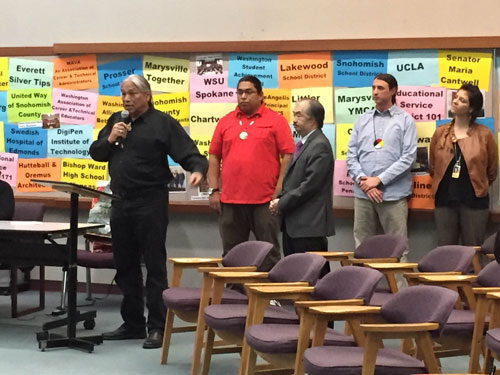
By Brandi N. Montreuil, Tulalip News
MARYSVILLE – “Our community has been shaken, shaken very hard by the events of October 24,” said new Recovery Directory Mary Schoenfeldt for the Marysville School District during a community meeting held on December 11, at Cedarcrest Middle School.
The meeting featured two topic agendas. For the first hour parents learned how to help their children process grief during the holidays. The remainder of the meeting focused on the future of the Marysville-Pilchuck High School cafeteria. Parents were able to voice their opinions during mini breakout sessions on what the school district should do to move forward.
The cafeteria was the location where 15-year-old Tulalip tribal member, Jaylen Fryberg, shot six students, killing five including himself. Since the October 24 incident the cafeteria has remained closed out of respect for students and the victims of the shooting. Now the school district is holding surveys asking the Marysville/Tulalip communities what they would like the future of the cafeteria to entail.
Before the breakout sessions, Schoenfeldt spoke to parents about depression and warning signs to look for in their children as the process of grief continues. “Your children will have a loss of concentration leading to short tempers or quick tempers. Watch for signs of grieving and depression in your children as suicide can become an issue.”
Schoenfeldt explained that students might have a hard time coping with the range of emotions that they are experiencing and may not know how to begin a conversation about how they are feeling. Many parents discussed the apprehension their children feel while at the school and trying to settle back into a routine. One mother expressed that her daughter texts frequently throughout the day as a way to cope and that she does not want to eat lunch at the school.

“Acknowledge that you are also having a hard time coping with your feelings. Acknowledging it with your child helps to make it a topic for discussion. Be available emotionally to your kids to listen to them,” said Schoenfeldt.
Following a brief Q&A with Schoenfeldt, parents were then invited to share their thoughts regarding the status of the cafeteria, which was built in 1970. The school district is seeking state funding to help rebuild the cafeteria.
Students temporarily are eating in the gym. “Right now we are just talking, where do we want the kids to eat? It can’t keep being at the gym forever,” said Dr. Becky Berg, Marysville School District Superintendent.
To decide if the cafeteria should be completely torn down or remodeled, the district had the community participate in a Thoughtexchange survey on the district’s website. “The intent is to get all our voice to the table and also include the students’ voices,” said Berg. The survey, which closed December 12, will be presented to the board.
“The intent of tonight, at this point, is to use these breakout sessions for those who haven’t been online yet and discuss possibilities that we haven’t considered,” said Berg.
Many participants expressed they would like to see the cafeteria radically changed in appearance so it would not be such a visible reminder of the October 24 event. Other suggestions included building in a new location, building in a contingency area or simply tearing it down.
The district is currently reviewing the surveys and waiting for funding approval. Berg remarked that while changes will take some time, it is being fast tracked for the students. “This will not be an overnight process. We are all first timers at this and hopefully last timers at this. Let’s keep talking and supporting each other.”
Brandi N. Montreuil: 360-913-5402; bmontreuil@tulalipnews.com


















